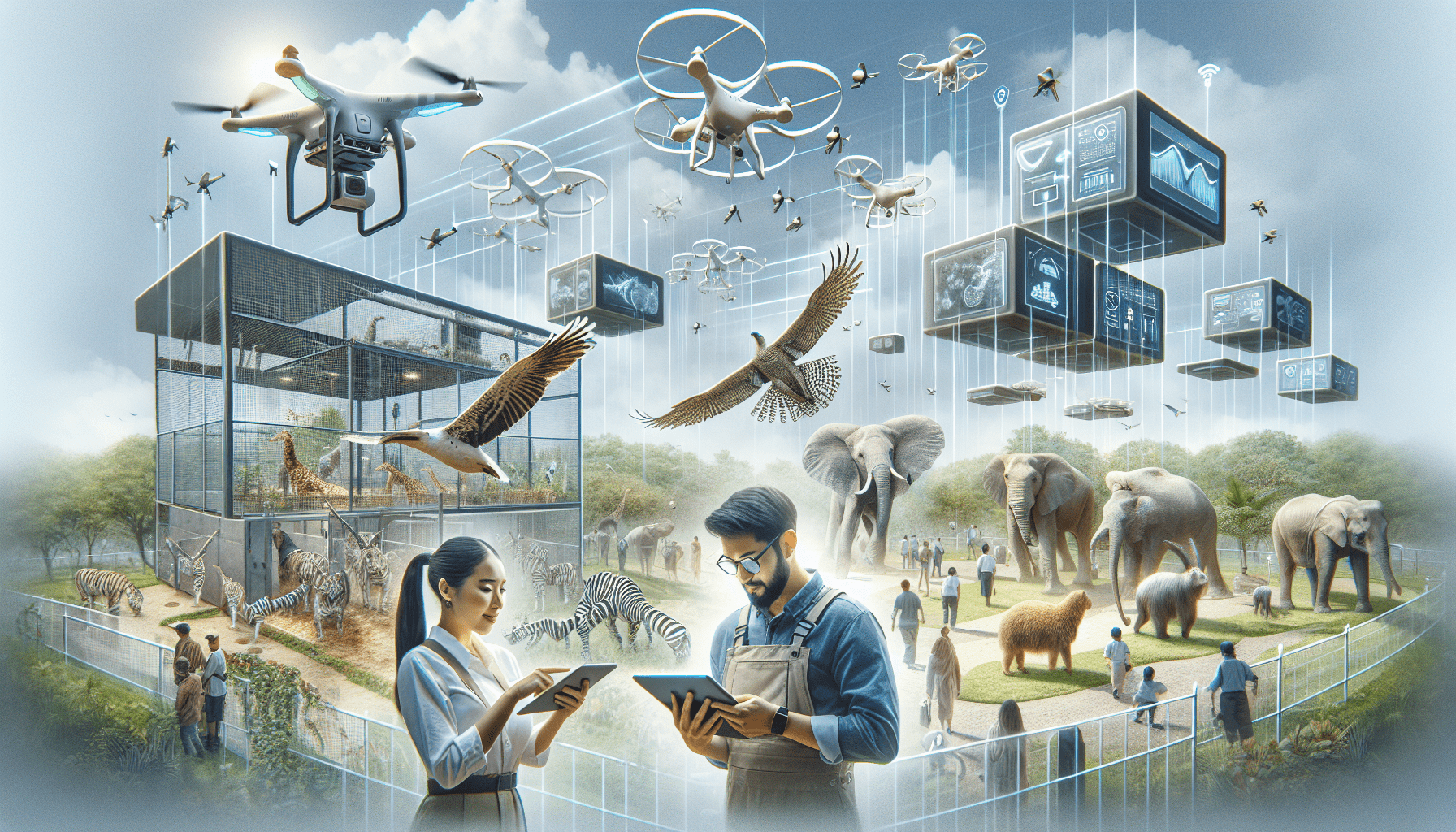Imagine having a reliable companion to guide you in the world of zookeeping, providing you with invaluable assistance and support. Enter “Virtual Zookeeping Assistance”, a groundbreaking technological solution designed to revolutionize the way zookeepers nurture and care for the animal kingdom. This innovative system combines advanced sensors, augmented reality, and artificial intelligence to enhance the overall management of zoos, ensuring the well-being and happiness of all their precious inhabitants. With Virtual Zookeeping Assistance by your side, you can embark on an awe-inspiring journey into the realm of virtual wildlife conservation, where expertise meets technology in perfect harmony.

What is Virtual Zookeeping Assistance?
Definition
Virtual Zookeeping Assistance refers to the use of technology, specifically virtual reality (VR) technology, to remotely assist in the management and care of animals in zoos. It involves the use of remote monitoring, data analysis, and virtual reality tools to ensure the safety, well-being, and health of animals in a zoo.
History
The concept of Virtual Zookeeping Assistance emerged in the early 2000s as zoos began to explore the potential applications of modern technology in animal care. Virtual reality technology and remote monitoring systems have been rapidly advancing, making it possible for zookeepers to remotely monitor and interact with animals in their enclosures. This innovation has opened up new possibilities for the management of zoos and has revolutionized the way in which keepers care for and engage with animals.
Benefits
Virtual Zookeeping Assistance offers numerous benefits to both the animals and the zookeepers. One of the main advantages is the improved safety for both animals and zookeepers. By utilizing virtual reality technology, keepers can monitor and interact with animals from a safe distance, reducing the risk of accidents or injuries. Additionally, virtual zookeeping assistance can significantly reduce costs, as it eliminates the need for physical presence and allows keepers to manage multiple enclosures simultaneously. This technology also enhances animal welfare by providing enrichment opportunities through virtual experiences, while still maintaining the animals’ natural habitats and routines.
How does Virtual Zookeeping Assistance work?
Virtual Reality Technology
Virtual reality technology plays a crucial role in virtual zookeeping assistance. By using VR headsets and cameras, zookeepers can immerse themselves in a virtual representation of the animal’s enclosure. This allows them to observe and interact with the animals as if they were physically present. Virtual reality technology also enables keepers to simulate enrichment activities, such as providing virtual prey for carnivorous animals or virtual toys for primates, promoting mental and physical stimulation.
Remote Monitoring
Remote monitoring systems are integral to the functioning of virtual zookeeping assistance. These systems consist of cameras, sensors, and other monitoring devices installed in the animal enclosures. Zookeepers can access these feeds through their virtual reality headsets or other devices, enabling them to observe the animals in real time. This remote monitoring allows keepers to closely monitor the animals’ behavior, detect any signs of distress or illness, and intervene promptly when necessary.
Data Analysis
Data analysis plays a crucial role in virtual zookeeping assistance. The cameras and sensors used in remote monitoring collect a vast amount of data, including animal behavior patterns, feeding habits, and health parameters. By analyzing this data, zookeepers can gain valuable insights into the animals’ well-being and make informed decisions regarding their care. Data analysis also helps identify any potential issues or anomalies in the animals’ behavior, facilitating early intervention and preventive measures.
The Role of Virtual Zookeepers
Training
Virtual zookeepers undergo extensive training to effectively perform their role. They are trained in the use of virtual reality technology, remote monitoring systems, and data analysis tools. This training provides them with the necessary skills to navigate virtual environments, interpret data, and make informed decisions regarding animal care. Additionally, virtual zookeepers receive specialized training in animal behavior and health, enabling them to monitor and address any issues that may arise.
Monitoring Animal Behavior
One of the primary responsibilities of virtual zookeepers is to monitor animal behavior. Using virtual reality technology and remote monitoring systems, keepers can closely observe the animals’ activities, social interactions, and overall well-being. They pay attention to changes in behavior, such as signs of aggression, changes in appetite, or abnormal movement patterns. By closely monitoring animal behavior, virtual zookeepers can detect early signs of distress, illness, or any other issues that may require intervention.
Managing Feeding and Health
Virtual zookeepers also play a crucial role in managing the feeding and health of the animals in their care. Through remote monitoring, they can ensure that the animals are receiving proper nutrition and that their dietary needs are being met. Virtual zookeepers can also remotely control feeding devices, ensuring that each animal receives the appropriate amount and type of food. In terms of health management, virtual zookeepers can monitor vital signs, administer medications remotely if necessary, and coordinate with on-site veterinary staff for any medical procedures.
Benefits of Virtual Zookeeping Assistance
Improved Safety
Virtual zookeeping assistance significantly enhances safety for both animals and zookeepers. By utilizing virtual reality technology and remote monitoring, keepers can avoid direct physical contact with potentially dangerous animals, such as large predators. This minimizes the risk of injuries or accidents and provides a safer work environment for zookeepers.
Reduced Costs
Virtual zookeeping assistance offers a cost-effective solution for zoos. By eliminating the need for zookeepers to be physically present in every enclosure, costs associated with staffing, infrastructure, and equipment can be reduced. Virtual zookeepers can manage multiple enclosures simultaneously, optimizing labor resources and reducing operational expenses.
Enhanced Animal Welfare
By providing virtual experiences and stimulation, virtual zookeeping assistance enhances animal welfare. Zookeepers can create virtual environments that closely resemble the animals’ natural habitats and provide enrichment activities tailored to their specific needs. This helps prevent boredom, encourages natural behaviors, and promotes overall well-being for the animals.

Challenges and Limitations
Technical Limitations
Despite its numerous benefits, virtual zookeeping assistance is not without its challenges and limitations. One of the main technical limitations is the dependency on stable and reliable internet connections. Any interruptions or delays in connectivity can hinder the real-time monitoring and communication between virtual zookeepers and on-site staff, potentially impacting the animals’ safety and care.
Human-Animal Interaction
Virtual zookeeping assistance raises questions about the impact on human-animal interactions. While the technology allows for remote monitoring and care, it cannot completely replace the physical presence of zookeepers. Some argue that physical interactions and human connection are essential for the well-being of animals, and that virtual experiences may not fully meet their social and emotional needs.
Public Perception
Another challenge associated with virtual zookeeping assistance is public perception. Some individuals may view the technology as a replacement for traditional zookeeping practices, raising concerns about the authenticity and value of the zoo experience. Educating the public about the benefits and limitations of virtual zookeeping assistance is crucial to ensure widespread acceptance and understanding of this innovative approach.
Successful Examples of Virtual Zookeeping Assistance
Virtual Penguin Experience at San Diego Zoo
One successful example of virtual zookeeping assistance is the Virtual Penguin Experience at the San Diego Zoo. Visitors can don virtual reality headsets and immerse themselves in a virtual environment that simulates the penguin habitat. This interactive experience allows visitors to observe the penguins up close, learn about their behavior, and gain a deeper understanding of their conservation needs. The virtual experience complements the physical exhibits and educational programs, enhancing visitor engagement and contributing to the conservation message.
Virtual Elephant Interaction at Singapore Zoo
The Singapore Zoo has also implemented virtual zookeeping assistance in its elephant exhibit. By using virtual reality technology, visitors can observe the elephants’ daily routine, learn about their natural behaviors, and virtually interact with them. This innovative approach provides an immersive and educational experience, while also ensuring the safety and well-being of both the visitors and the elephants.
Virtual Safari at South Africa’s Kruger National Park
Kruger National Park in South Africa has embraced virtual zookeeping assistance to offer visitors a virtual safari experience. Through interactive virtual reality technology, visitors can explore various areas of the park, observe wildlife in their natural habitat, and learn about conservation efforts. This virtual safari not only provides a unique and accessible experience for visitors but also offers an additional revenue stream for the park, helping to support conservation initiatives.

Future of Virtual Zookeeping Assistance
Advancements in Technology
The future of virtual zookeeping assistance holds great potential with advancements in technology. As virtual reality technology continues to evolve, it is likely to become even more immersive and realistic, providing an increasingly authentic experience for both zookeepers and visitors. Advancements in artificial intelligence and data analysis will also contribute to the optimization of animal care and management, allowing for more accurate monitoring and early intervention.
Expanding Virtual Experiences
Virtual zookeeping assistance is expected to expand beyond the confines of zoos, reaching a wider audience. It is likely that virtual experiences will be made available online, enabling individuals from around the world to connect with animals and learn about conservation efforts. This virtual outreach has the potential to increase awareness about wildlife conservation, foster empathy, and inspire individuals to actively participate in conservation initiatives.
Integration with Conservation Efforts
Virtual zookeeping assistance is poised to play a significant role in conservation efforts. By providing immersive and educational experiences, it can help raise awareness about endangered species, their habitats, and the importance of conservation. Virtual reality technology can also be utilized in wildlife rehabilitation centers to assist in the reintegration of captive animals into their natural habitats, ensuring a smooth transition and minimizing stress.
Ethical Considerations
Balancing Virtual and Physical Interactions
Ethical considerations arise when considering the balance between virtual and physical interactions with animals. While virtual zookeeping assistance offers numerous benefits, it is essential to ensure that physical interactions are not entirely replaced. Zookeepers and visitors engaging directly with animals contribute to their social and emotional well-being. Virtual experiences should be seen as complementing and enhancing these interactions, rather than replacing them.
Ensuring Animal Wellbeing
Animal wellbeing is of utmost importance in virtual zookeeping assistance. Care must be taken to ensure that the virtual experiences provided mimic the animals’ natural behaviors and habitats accurately. It is essential to continuously evaluate the impact of virtual experiences on the animals, monitor stress levels, and make adjustments as necessary. The well-being and comfort of the animals should always be the top priority.
Maintaining Authentic Zoo Experience
Virtual zookeeping assistance should aim to maintain an authentic zoo experience for visitors. While virtual reality technology provides exciting opportunities, it should not overshadow the value of physical encounters with animals. Efforts should be made to strike a balance between virtual and physical experiences, ensuring that visitors have the opportunity for direct engagement with animals and gain a deeper understanding of their conservation needs.

Conclusion
Virtual zookeeping assistance is a rapidly evolving field that offers numerous benefits and possibilities for the management and care of animals in zoos. By incorporating virtual reality technology, remote monitoring, and data analysis, virtual zookeepers play a crucial role in ensuring the safety, well-being, and health of the animals. While challenges and limitations exist, successful examples have shown the potential of virtual zookeeping assistance in enhancing animal welfare, reducing costs, and providing immersive educational experiences. The future of virtual zookeeping assistance holds exciting advancements in technology, expanding virtual experiences, and integration with conservation efforts. However, ethical considerations regarding human-animal interactions, animal well-being, and maintaining an authentic zoo experience must remain at the forefront of development and implementation efforts. Further research and exploration are essential to unlock the full potential and benefits of virtual zookeeping assistance.
